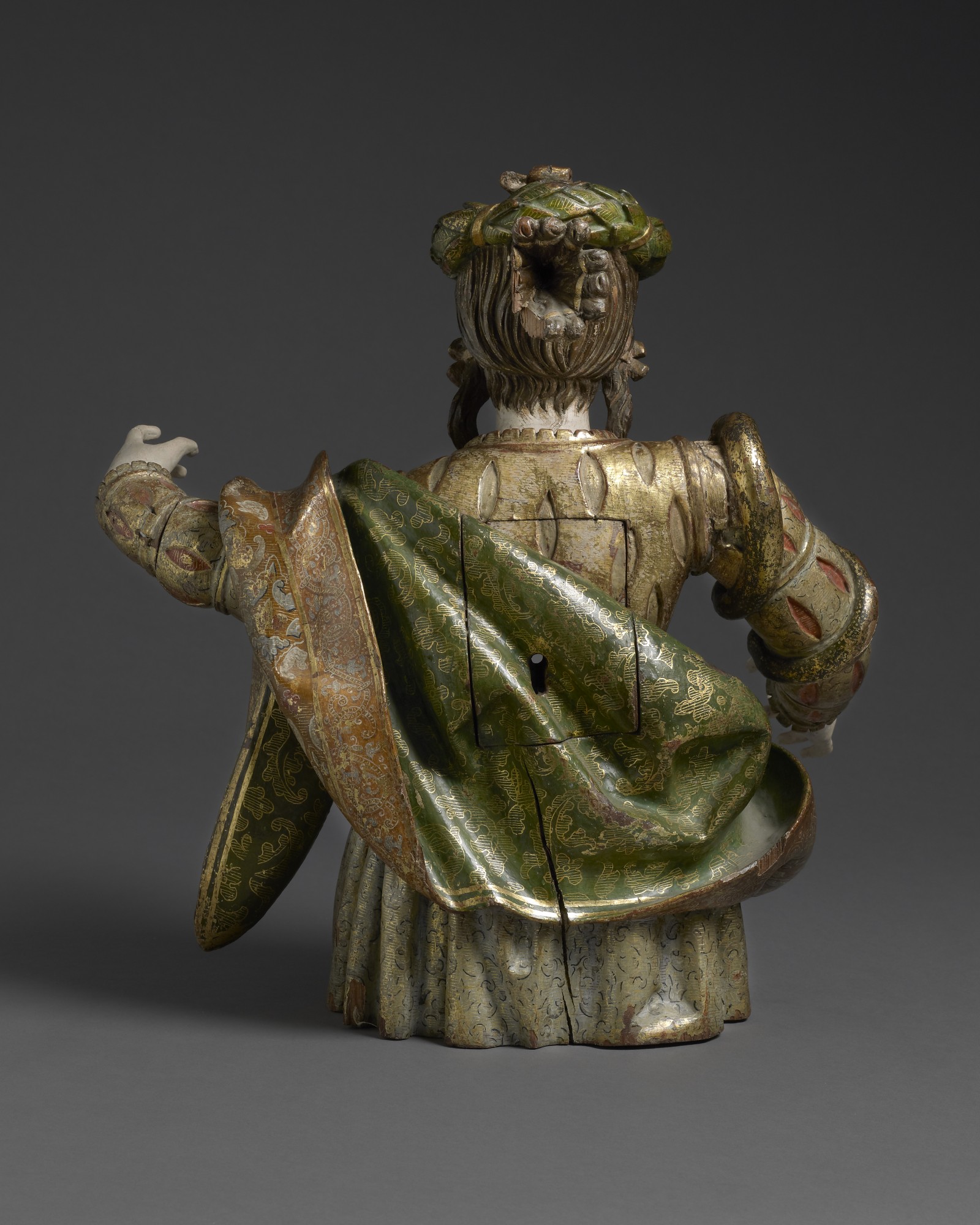


Thecla
Susanna
Private collection, Belgium
Of the finest quality and in exceptional original condition, this rare pair of busts in the form of reliquaries represents Saints Thecla and Susanna, two young Christian maidens venerated as models for female piety.
Saint Thecla appears in richly decorated costume, comprising a gold dress with slit top, back and sleeves, clinched at the waist with a twisted belt, and green brown drapery highlighted with gold motifs and borders. A serpent wraps itself around her right arm resting its head on her right shoulder to stare at the viewer. With a beautiful young face, she is adorned with a pearl necklace and cross which sits on her décolletage and with a crown of leaves. Her hair, shoulder length to the front and secured with gold ribbons, is gathered and tied in a high chignon. She has brown glass eyes.
Saint Susanna is also swathed in beautifully decorated clothing, comprising a grey blue dress with elaborate slit puff sleeves, tied at the waist with a gold belt and clasp, and gold and red drapery. She wears a more elaborate drop pearl necklace and a crown of flowers under which her long hair is swept at the front. A large gold bow and ribbon tie her hair in a chignon leaving wavy locks to fall below her shoulders. She holds a closed book with gold clasps in her left hand. She has blue-grey glass eyes.
Thecla was a young unmarried girl from a noble family who lived in Iconium, near Antioch in the region of Galatia in modern Turkey. She lived during the period following the crucifixion of Jesus when Paul the Apostle was spreading the Christian faith. Paul travelled to Iconium where he gave his sermons in the house of Onesiphorus. Thecla listened to Paul's discourse on virginity from her window in an adjacent house. Enraptured, she did not move for days. Thecla's mother, Theocleia, and her fiancé, Thamyris, became concerned that Thecla would follow Paul's demand to fear only one God and live in chastity, and they formed a mob to drag Paul to the governor who imprisoned the apostle. Thecla bribed a guard to gain entrance to the prison and sat at Paul's feet all night listening to his teachings. When her family found her, both she and Paul were again brought before the governor. At her mother's request, Paul was sentenced to scourging and expulsion and Thecla to be killed by being burned at the stake. Stripped naked, Thecla was put on the fire, but was saved by a miraculous storm which God sent to extinguish the flames.
Reunited, Paul and Thecla traveled to Pisidian, Antioch where a nobleman named Alexander desired Thecla and attempted to take her by force. Thecla fought him off, assaulting him in the process. She was placed before the governor for assaulting a nobleman and, despite the protests of the city's women, Thecla was sentenced to be eaten by wild beasts. To ensure that her virtue remained intact at her death, Queen Tryphaena took her into protective custody overnight.
Thecla was tied to a lioness and paraded through the city. She was then stripped and thrown to beasts provided by Alexander. Thecla was protected from death, first by the lioness who fought off the other beasts and then by a series of miracles. She was thrown into a valley with poisonous snakes. God gave rise to a fire which destroyed the snakes. Finally, the women of the city and Tryphaena intervened to free her. Thecla rejoined Paul at Myra in Lycia, having cut her hair and dressed as a boy. She accompanied him on his missionary travels and then continued preaching alone helping the sick and poor. She is invoked against infectious disease, a reference to her liberation of the city of Este from the plague, the subject of Giovanni Battista’s celebrated work in the town cathedral painted in 1758–1759. On one version of the legend, Thecla became a recluse in a cave at Meriamlik near Seleucia living there for the next 72 years.
Susanna, a virtuous and beautiful young Jewish woman, was saved from a false accusation of adultery by Daniel, a young prophet. The daughter of Hilkiah, Susanna married Joiakim, a wealthy and prominent Jew among the exiles in Babylon. The same year as her marriage, two wicked elders were appointed judges for the community of exiles. Obsessed with Susanna’s beauty, they often visited Joiakim's house lusting after his young wife. They hid in the garden watching Susanna bathe. The voyeurs then sprang out and demanded that she commit adultery with them both then and there. If she refused, they told her, they would report that she was caught in the act of adultery with a young man. Susanna refused to sin against God and the two elders uttered their false accusations. Susanna was tried, with her two accusers acting both as judges and witnesses. She was sentenced to death.
As she was led to her execution, Susanna prayed to God to save her. He answered her prayer, inspiring the young prophet Daniel to come to her aid. On his assertion that the elders had borne false witness against Susanna and that they had not been properly examined during trial, she was returned to court and the trial was resumed. With precocious wisdom, Daniel then examined the elders separately revealing that their testimony was contradictory and false. The elders were found guilty of perjury, sentenced to death and executed. Susanna was returned to her husband and family.
SOLD: Private collection, Belgium